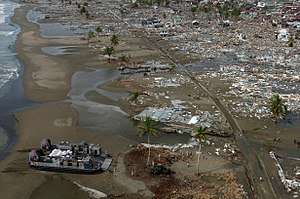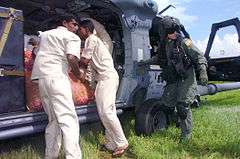Operation Unified Assistance
Operation Unified Assistance was the American military's humanitarian response to the 2004 Indian Ocean earthquake and tsunami. On 28 December 2004, elements of the Combined Support Force were deployed to U-Tapao International Airport in Thailand. More than 12,600 Department of Defense personnel were involved in the relief effort.

Background
The United States dispatched numerous C-5 and C-17 strategic airlifters and 10 C-130 Hercules tactical airlifters containing disaster supplies, 9 P-3C Orion maritime patrol aircraft for search and rescue support, and several teams from the Department of State and the Department of Defense to coordinate additional assistance from Utapao Naval Air Base in Thailand.
Carrier Strike Group 9 was dispatched to the coast of Sumatra to provide support to the Indonesian province of Aceh. It was led by the Abraham Lincoln, with support from the Shiloh, Shoup, Benfold, and Rainier.
An Expeditionary Strike Group led by the amphibious assault ship Bonhomme Richard, scheduled for a port call in Guam, was dispatched to render assistance. A total of 48 Navy and Marine Corps helicopters were involved. Each ship could produce around 90,000 US gallons of fresh water per day. Other ships in the group were amphibious transport dock Duluth, the guided-missile destroyer Milius, the dock landing ship Rushmore, the guided-missile frigate Thach, the nuclear-powered submarine Pasadena, guided-missile cruiser Bunker Hill, and the coast guard cutter Douglas Munro.

The US Navy also deployed the Mercy, a 1,000-bed hospital ship (initially staffed to support 250 patient beds). Other logistics ships were also employed such as the combat stores ships San Jose and Niagara Falls.
In January 2005, 24 Navy ships and one Coast Guard vessel were in the area. Among those ships was the amphibious assault ship USS Fort Mchenry (LSD43), USS Essex (LHD-2) which relieved the Bonhomme Richard, and assumed the duties as the primary rotary wing platform for the operation. USS Essex (LHD-2) also brought helicopter detachments. The last ship, USS Mercy, departed the region in April 2005.
Indonesian public opinion of the United States markedly improved in the year after the tsunami, jumping from 15% in 2003 to 38% in 2005, going against the general trend of less favorable attitudes towards America in that time period.[1] Many Indonesians surveyed indicated that American relief efforts generally improved their view of the United States.[2]
See also
- Operation Unified Response, for the 2010 Haiti earthquake
- Operation United Assistance, for the 2014 Ebola virus epidemic in West Africa
References
- "No Global Warming Alarm in the U.S., China" (PDF). Archived from the original (PDF) on 1 December 2007. Retrieved 2 January 2008.
- "2006 Poll: Humanitarian Relief Sustains Change in Muslim Public Opinion". Terror Free Tomorrow. Retrieved 2 January 2008.
External links
- "Hospital Ship Mercy Sails for Indian Ocean". 3rd Fleet Public Affairs, USN. 6 January 2005. Retrieved 2 January 2008.
- "Tsunami aid: Who's giving what". BBC. 27 January 2005. Retrieved 2 January 2008.
- "Essex Thanked For Delivering Relief Supplies". USS Essex Public Affairs. 11 February 2005. Retrieved 13 April 2011.
- "MH-53 Sea Dragon helicopter assigned to the Blackhawks of Helicopter Mine Countermeasures Squadron Fifteen (HM-15)". 24 January 2005. Retrieved 25 September 2010.